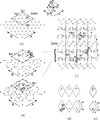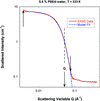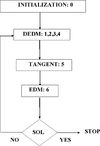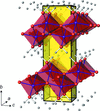issue contents
August 2010 issue

Cover illustration: PDB_REDO optimization of the oldest structure with experimental data in the PDB [155c; Timkovich & Dickerson (1976). J. Biol. Chem. 251, 4033-4046]. Front: final structure - warmer colours show greater atomic displacement. Back: final structure model with atomic trajectories in yellow. Courtesy of Joosten et al. [J. Appl. Cryst. (2009), 42, 376-384].
research papers
This paper describes use of the Student t-distribution to extend the applicability of likelihood methods for absolute structure assignment.
Open  access
access
 access
accessApplication of phenix.model_vs_data to the contents of the Protein Data Bank shows that the vast majority of deposited structures can be automatically analyzed to reproduce the reported quality statistics. However, the small fraction of structures that elude automated re-analysis highlight areas where new software developments can help retain valuable information for future analysis.
The intensity distributions of the Bragg reflections and streaks from 2H-NaxCoO2·yD2O (x ≃ 0.35, y ≃ 1.3) in reciprocal space and their contributions to the powder diffraction pattern are calculated for each HKζ, based on the short-range order stacking model using the matrix method, and illustrated.
The resolution function parameters (geometric contributions as well as wavelength spreads) for the KWS-2 instrument at FRM II have been determined from the small-angle neutron scattering curve of a colloidal silica dispersion with known structure parameters.
Formulae for calculating incident and diffracted beam path lengths have been used to calculate the absorption correction in a range of cylindrical geometries. The degree to which this correction is altered by absorption in the capillary used to contain cylindrical specimens, or in the core used to support annular specimens, is shown.
Download citation


Download citation


Ni0.9Zn0.1O nanoparticles annealed in the temperature range 773–1223 K have been studied. The application of a cubic space group to describe the magnetic phase and neglect of a trigonal strain produced by magnetic ordering may result in structure and microstructure modelling errors.
A large and unidirectional single crystal of L-cysteine hydrochloride monohydrate has been grown for the first time by the recently invented Sankaranarayanan–Ramasamy method. This crystal was found to possess good nonlinear optical properties, which, along with other optical and dielectric properties, revealed that the title compound is a good candidate for photonic applications.
A new Guinier–Porod empirical model is introduced to fit small-angle scattering data from spherical and nonspherical objects such as rods or platelets. This model is used to fit small-angle scattering data from a Pluronic solution that sequentially forms unimers, spherical micelles, cylindrical micelles and lamellar micelles on heating.
Anomalous thermal expansion of cobalt olivine, Co2SiO4, is studied by means of both neutron powder and single-crystal diffraction at low temperatures.
A versatile setup for in situ synchrotron small/wide-angle X-ray scattering (SAXS/WAXS) and pair distribution function (PDF) measurements of supercritical fluid reactions has been developed.
A set of 16 polymers was tested for protein crystallization and two new polymer-based protein crystallization screens were formulated.
The nonhydrostatic stress states that are developed in the pressure media within diamond-anvil pressure cells have been investigated by single-crystal X-ray diffraction. The results confirm that the stress state is effectively cylindrically symmetrical with the stress parallel to the load axis being greater than the radial stresses.
Automated microseeding protocols are presented.
Download citation


Download citation


Titanium oxyflouride, TiOF2, synthesized via a metathetic displacement reaction, was found to possess a hexagonal (R c) crystal structure at room temperature, unlike previous reports for this material. Upon heating through 333–338 K, the hexagonal TiOF2 transformed into a cubic (Pm
c) crystal structure at room temperature, unlike previous reports for this material. Upon heating through 333–338 K, the hexagonal TiOF2 transformed into a cubic (Pm m) polymorph.
m) polymorph.
A pneumatic diamond anvil cell for high-pressure macromolecular crystallography is described, and data collection is reported with a robotic arm acting as a goniometer.
Hexagonal lattice parameters of various apatite compounds, M10(TO4)6X2, were predicted from their ionic radii by artificial neural networks. Simple mathematical formulas were derived for the prediction of lattice parameters by using average ionic radii as independent variables.
The cubic phase of zirconia is stable at room temperature with decreasing crystallite size. High strain, thermal displacement of atoms and oxygen vacancy play important roles in the thermodynamic phase stability of nanocrystalline zirconia.
Analytical formulas are obtained for describing small-angle scattering from generalized Cantor fractals, whose dimensions can be varied from zero to three. The influence of polydispersity on the scattering is considered.
A dual-space resolution bias correction algorithm has been developed to reduce the truncation effects on electron density maps. The new algorithm has been checked on a set of powder patterns.
Two distinct lead-free piezoceramics were investigated by X-ray, neutron and electron diffraction. The experiments revealed the coexistence of rhombohedral R3c and tetragonal P4bm phases.
Citations to 46 scientific articles published by authors based at the Cambridge Crystallographic Data Centre and by external users of the Cambridge Structural Database have been retrieved. Analyses by number of citations and their origins in terms of journals, subject areas and geographic regions are reported.
A new phasing method, based on difference electron-density modification techniques, is described for obtaining the correct structure from a random model.
A novel two-dimensional small-angle X-ray scattering pattern analysis method is presented which extracts parameters characterizing the radius, length and polydispersity of scatterers in heat-treated and precursor poly(p-phenylene terephtalamide) fibres.
The form factor of a helical tape with N layers is presented. The form factor is used to characterize an intermediate stage in the formation of graphitic nanotubes that self-organize in a two-dimensional hexagonal arrangement.
Nanocrystalline boehmite (AlOOH) was synthesized under continuous flow in sub- and supercritical water. The reaction temperature- and pressure-dependent particle size and morphology were studied using powder X-ray diffraction and transmission electron microscopy.
The diffuse X-ray scattering from partially transformed 3C-SiC single crystals is quantitatively analyzed. The transformation mechanisms and the transformation levels are unambiguously determined.
X-ray powder diffraction on proteins for identification of polymorphs and precipitates can be carried out on in-house equipment. Experimental patterns compare very well with calculated patterns after correction for background, unit-cell parameters, disordered bulk solvent and geometric factors.
Structural characterization of crystalline diamond plates on dome-like carbon particles has been carried out using X-ray diffraction and transmission electron microscopy. Application of the Scherrer formula to grain-size analysis, and a possible mechanism for the synthesis of diamond plates and their use in field emission, are discussed.
Texture and residual stress analysis using X-ray diffraction has been carried out on zirconium alloy cladding tubes after cold pilgering. A quantitative interpretation of the influence of intergranular stresses on the analysed stress development has been performed using a polycrystalline model.
The Bonse–Hart reflectivity functions for a multi-bounce crystal exhibit nearly rectangular profiles, which are different from the experimental results. The results presented here lead to nearly theoretical Bonse–Hart reflectivity profiles and improved sensitivity for the next generation of double-crystal diffractometers.
short communications
An improved automated approach to extraction of individual mosaic domains from a sequence of topographic images is presented. The only user input is the number of domains that are to be searched for.
A refinement strategy for Monte Carlo modelling of diffuse scattering from molecular crystal systems
A new strategy for modelling diffuse scattering from molecular crystals using Monte Carlo simulation is described. Use is made of a simple empirical formula to specify spring constants and provide an objective means for limiting the number of springs needed.
CIF applications
Free 

A .NET class library for STAR/CIF manipulation, ASTAR, has been developed.
Free 

The application publCIF is described, with emphasis on its usefulness in validating the syntax and contents of CIFs, and in managing other resources useful for the publication of CIF-based articles.
computer programs
LauePt is a robust and extremely easy-to-use Windows application for accurately simulating, indexing and analyzing white-beam X-ray diffraction Laue patterns of any crystals under arbitrary diffraction geometry.
A software package for performing modelling and analysis of GISAXS data within the distorted wave Born approximation has been developed using the IGOR Pro scripting language.
laboratory notes
A method is described for growing large crystals of proteins; a cut pipette tip is used to hang large-scale droplets (maximum volume 200 µl), enabling the effective manipulation of crystals and the removal of spontaneously nucleated crystals. Large-volume crystals so obtained diffracted neutrons to beyond 3.5 Å resolution.
A new automated system for the ligand soaking of protein crystals has been developed.
crystallographers
Free 

Free 

book reviews
Free 



 journal menu
journal menu





























































